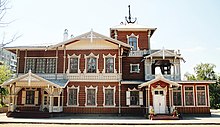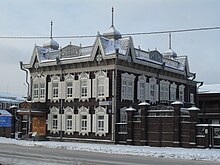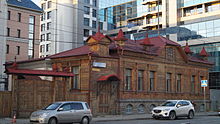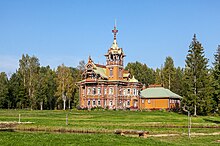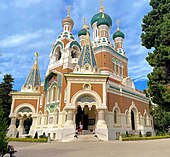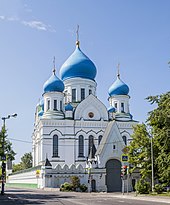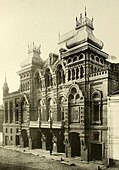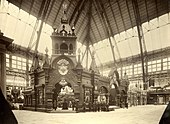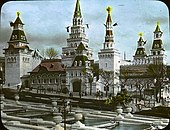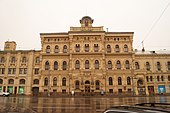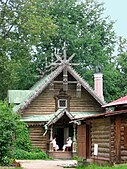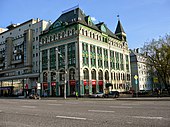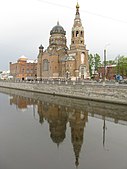
Konstantin Andreyevich Thon, also spelled Ton was an official architect of Imperial Russia during the reign of Nicholas I. His major works include the Cathedral of Christ the Saviour, the Grand Kremlin Palace and the Kremlin Armoury in Moscow.

Neo-Byzantine architecture was a revival movement, most frequently seen in religious, institutional and public buildings. It incorporates elements of the Byzantine style associated with Eastern and Orthodox Christian architecture dating from the 5th through 11th centuries, notably that of Constantinople and the Exarchate of Ravenna.

Khamovniki District is a district of Central Administrative Okrug of the federal city of Moscow, Russia. Population: 102,730 (2010 Russian census); 97,110 (2002 Census).
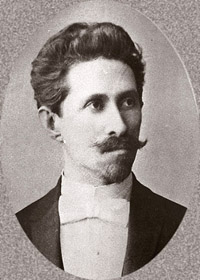
Alexander Nikanorovich Pomerantsev was a Russian architect and educator responsible for some of the most ambitious architectural projects realized in Imperial Russia and Bulgaria at the turn of the 20th century. An accomplished eclecticist, Pomerantsev practiced Art Nouveau, Byzantine, Russian Revival styles and collaborated with leading structural engineers of his period in creating new types of commercial buildings.

David Ivanovich Grimm was a Russian architect, educator and historian of art specialising in the Byzantine Empire, Georgia and Armenia. Grimm belonged to the second generation of Russian neo-Byzantine architects and was the author of Orthodox cathedrals in Tbilisi, Chersonesos and smaller churches in Russia and Western Europe. Grimm was a long-term professor at the Imperial Academy of Arts and chaired its department of architecture in 1887–1892.

Dorogomilovo District is a district of Western Administrative Okrug of the federal city of Moscow, Russia. The area of the district is 7.93 square kilometres (3.06 sq mi). Population: 67,720 (2010 Russian census); 59,732 (2002 Census). Postal codes: 113000 to 119000.
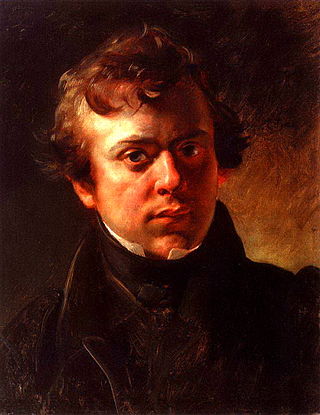
Alexey Maksimovich Gornostaev was a Russian architect, notable as a pioneer in Russian Revival, the builder of Valaam Monastery hermitages, Trinity-Sergius Convent in Saint Petersburg and Uspenski Cathedral in Helsinki. He is credited with the rebirth of traditional tented roof architecture of Russian North.

Fyodor Osipovich Schechtel was a Russian architect, graphic artist and stage designer, the most influential and prolific master of Russian Art Nouveau and late Russian Revival architecture.
Yefgraph Dmitrievich Tyurin was a Russian architect and art collector, famous as the builder of Elokhovo Cathedral in Moscow, the main cathedral of Russian Orthodox Church in 1945–2000, and Moscow State University expansion in 1830. Tyurin’s life and work, especially in his later years, was poorly documented. His life period is usually presented as 1792–1870, however, recent studies by Sophia Tyurina-Mitrokhina extend it, most likely, to 1793–1875.

Ivan Pavlovich Mashkov was a Russian architect and preservationist, notable for surveying and restoration of Dormition Cathedral of Moscow Kremlin, Novodevichy Convent and other medieval buildings. His best known extant building is Sokol (Falcon) luxury Art Nouveau apartment building in Kuznetsky Most Street, Moscow. A prolific architect, Mashkov built mostly eclectic buildings with Russian Revival features.
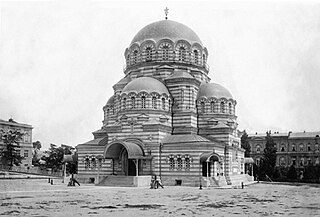
The St. Alexander Nevsky Military Cathedral of Tiflis was an Orthodox Christian cathedral in downtown Tiflis, Georgia, constructed during the Imperial Russian rule in 1871-1872 and 1889–1897 and demolished by the Soviet authorities in 1930. The novel design of the cathedral became a standard for the emerging Neo-Byzantine style well before the cathedral was completed.
The appearance of Saint Petersburg includes long, straight boulevards, vast spaces, gardens and parks, decorative wrought-iron fences, monuments and decorative sculptures. The Neva River itself, together with its many canals and their granite embankments and bridges help to give the city its particular ambience.
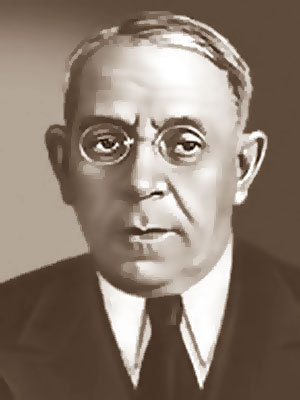
Vladimir Alekseyevich Shchuko was a Russian architect, member of the Saint Petersburg school of Russian neoclassical revival notable for his giant order apartment buildings "rejecting all trace of the moderne". After the Russian Revolution of 1917 Shchuko gradually embraced modernist ideas, developing his own version of modernized neoclassicism together with his partner Vladimir Gelfreikh. Shchuko and Gelfreikh succeeded through the prewar period of Stalinist architecture with high-profile projects like the Lenin Library, Moscow Metro stations and co-authored the unrealized Palace of Soviets. Shchuko was also a prolific stage designer, author of 43 drama and opera stage sets.

Russian neoclassical revival was a trend in Russian culture, most pronounced in architecture, that briefly replaced Eclecticism and Art Nouveau as the leading architectural style between the Revolution of 1905 and the outbreak of World War I, coexisting with the Silver Age of Russian Poetry. It is characterized by a merger of new technologies with a moderate application of classical orders and the legacy of the Russian Empire style of the first quarter of the 19th century.

The Naval cathedral of Saint Nicholas in Kronstadt is a Russian Orthodox cathedral built in 1903–1913 as the main church of the Russian Navy and dedicated to all fallen seamen. The cathedral was closed in 1929, was converted to a cinema, a House of Officers (1939) and a museum of the Navy (1980).

Russian-Byzantine architecture is a revivalist direction in Russian architecture and decorative and applied arts, based on the interpretation of the forms of Byzantine and Ancient Russian architecture. As part of eclecticism could be combined with other styles.

Karl Magnus Vitberg was a Russian Neoclassical architect of Swedish stock.

Abram or Avraam Melnikov was a Russian Neoclassical architect associated with the late phase of the Empire style. His teachers at the Imperial Academy of Arts included Andreyan Zakharov. He graduated with a gold medal and went to further his studies in Italy. Melnikov became de facto Dean of the Academy in 1831 but was not officially appointed until 1843.
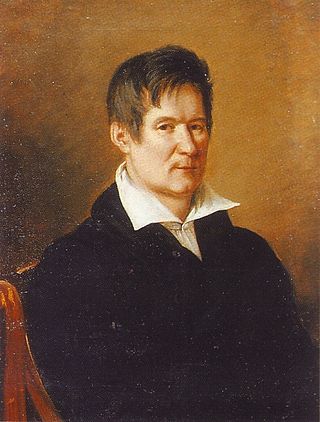
Duke Vasily Petrovich Stasov was a famous Russian architect, born into a wealthy noble family: his father, Pyotr Fyodorovich Stasov, came from one of the oldest aristocratic families founded in 1387 by the 1st Duke Stasov Dmitri Vasilevich and his mother, Anna Antipyevna, came from the prominent Priklonsky family

Russian Baroque is a term used to describe the Baroque artistic style that emerged in the Russian Tsardom and the Russian Empire during the late 17th and early 18th centuries. This style was mainly seen in Saint Petersburg and Moscow during the reigns of Peter the Great and Elizabeth of Russia.










